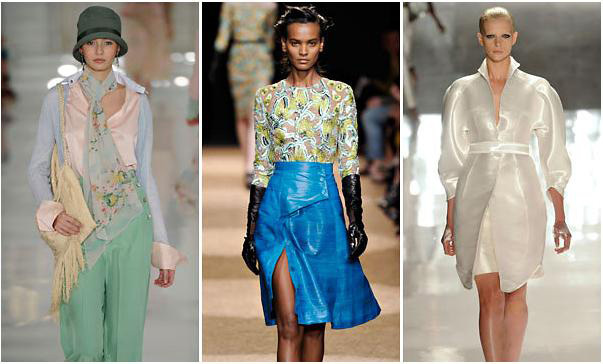Streamlining with Googie
Updated: 2011-09-20 11:12
(The New York Times)
|
|||||||||||
 |
|
From left, Ralph Lauren; Proenza Schouler, by Jack McCollough and Lazaro Hernandez; and Chado Ralph Rucci, spring-summer 2012, in New York.[Photo/The New York Times] |
New York fashion has gone Googie — and that is nothing like the weird mash-up that it sounds.
Instead, the 1950s utility architecture known as Googie, still seen in American bowling alleys, dance halls and Miami Beach hotels, proved an inspiration for bringing some fun to a powerful theme of the summer 2012 collections: streamlining.
Let's call the bold angles, shiny plate-glass-style surfaces and hyperclean silhouettes "live streaming." For at their best, American designers are riffing on past popular culture and bringing it back to life.
No one does the early era of speed — linear cuts and shimmering surfaces — better than Ralph Lauren, nor with more nostalgia.
His 1920s-inspired collection — "The Great Gatsby" without the decadence and ennui — lit up the last morning of New York shows with a pastel prettiness. The cloche hats, topping long, lean, soft pants or the designer's sleek columns of white satin, told the story. But so did the raffia wedge sandals. Mr. Lauren's sweet tooth for a pastel past is tempered with modernity.
This was a collection as sugary as the Ladurée macaroon store that just opened on Madison Avenue. But the vintage feel of the pallid flower prints, a torn effect on a crochet cardigan and leafy shades of green gave the show bite. So did the tailoring, as in a cute three-piece shorts suit.
The evening section was pure Ralph: streamlined gowns with just a fluffy feather boa to bring an echo of the Charleston.
At Proenza Schouler, a meld of Googie style with 1970s colors (not to mention the shag carpet runway), produced a witty and stylish collection. Component parts, like a papery eel skin A-line skirt, were simple. But the effect was in the visual shake-up of a jacket fitted to the body, like a suit for synchronized swimming, and worn with a pair of shorts; or a raffia skirt with a color-block top.
"Everything you see is not what you think it is," Jack McCollough said backstage, while his design partner, Lazaro Hernandez, described the architectural reference as part of an early automobile culture and a creation of Tomorrowland.
Tomorrow is the subject for the duo. A group of investors has bought a minority share in the company, offering an opportunity to expand the business with dedicated stores and a more realistic price point. Perhaps that freedom inspired the larky collection. But the workmanship and the imaginative mixes proved that streamlining can have more depth than just its modernist lines.
Michael Kors took his breezy, sporty style out of Africa this season — and the result of this fashion safari was mixed. The designer eschewed fashion's ubiquitous flower patterns in favor of a jungle of animal prints. The clothes came in earthy colors and sometimes with the rough Hessian surface expressed by the dry mesh of leaves that formed the backdrop. Mr. Kors described it as "rustic modernism" inspired by three trips this year to the Singita lodges in South Africa.
But such travelogues need filtering to work in the global world. (Ponchos in the city, anyone?) Had Mr. Kors taken the leopard or zebra prints and developed them digitally, he would have given more depth to the collection, although the introduction of trench coats and capes did offer the spring-weight styles that have mostly been missing from New York's high-summer looks.
And one front-row guest was ecstatic. Zoe Saldana, who played the blue-skinned female alien warrior in "Avatar," said she found the Kors African odyssey "so romantic."
Reed Krakoff is becoming a New York leader in the minimalist look that has deep research and high technique concealed behind its clean surfaces. The first effect is of clothes designed with a ruler and square, the tailoring built on a low waist, perhaps with knife pleats on a skirt. But the designer's modern architecture has moved closer to the body, and the subtle cuts, combined with transparent panels artfully built into the streamlined silhouette, made his collection less stern and more seductive.